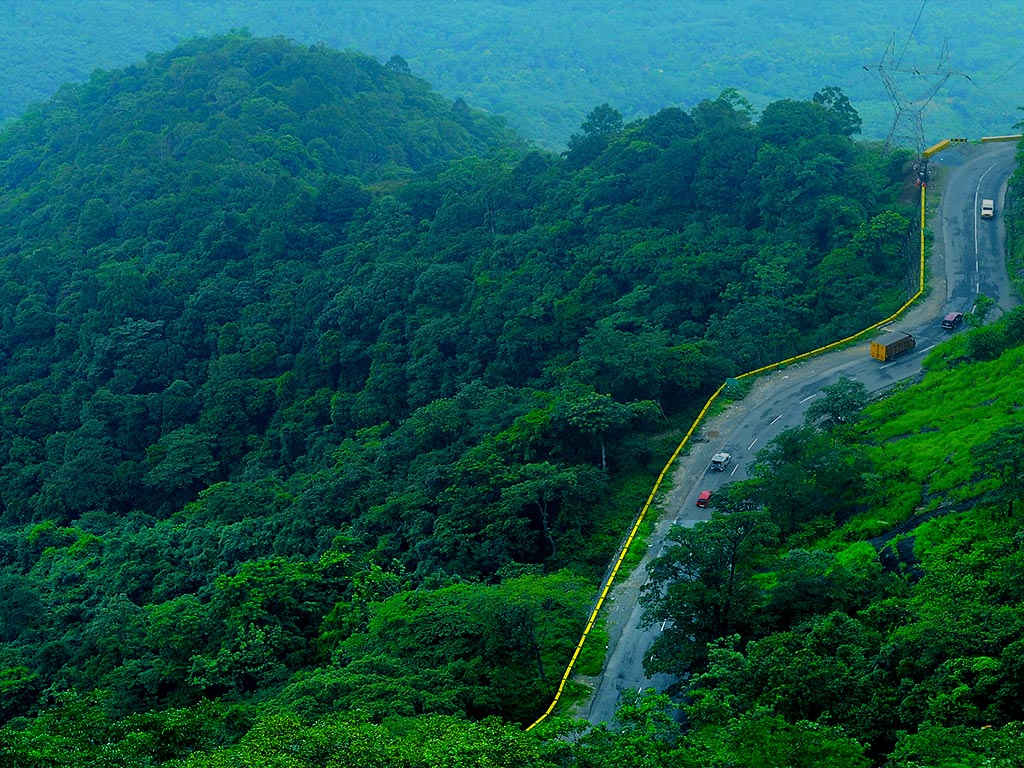

It is a dwelling that showcases nature’s skill and philosophy on architecture and you have to trek to about 4000 ft up a mountain to reach the place. We are talking about Edakkal Caves, which still remain a wonder and a mystery for archaeologists and historians alike.
Route to Edakkal Caves
Edakkal Caves are situated about 16 km from Sulthan Bathery and tourists have to trek up the Ambukuthi Hill to reach the caves. The trek up the hill, peppered with coffee plantations, is worth an experience and it takes almost 45 minutes to climb the hill. The lush greenery and scenic landscape around and the cool breeze that carries the aroma of coffee will surely make your journey an unforgettable one.
A remote ticket office is perched high on the top of the mountain and the tourists can buy entry tickets from there. The authorities will open before you an iron gate, and then you can enter a world of history, which has never ceased to allure people.
A telescope is installed a few feet from the caves. It offers a panoramic view of the surrounding country.
Structure
The name of Edakkal Caves literally means `a stone in between’. As the name indicates, it seems that one boulder miraculously wedged in between two bigger ones to create a cave.
Scientists too are of the opinion that Edakkal Caves is not a cave in the real sense. It is a fissure in the rocks which had been created due to natural causes/ changing climatic conditions. The split in the rock is about 22 ft. in width and 96 ft. in length. The depth of the cleft extends to over 30 ft and there is a large rock which has fallen forming a roof over it and this large cleft and the roof-rock gives it the appearance of a cave.
Legends and beliefs
There are many legends associated with the gigantic fissure at Edakkal. People believe that Lord Rama, one of the earlier visitors of this area, shot an arrow which pierced the mountain and created a deep cleft there. The name of the hills, Ambukuthy too is derived from this legend. (In Malayalam, Ambu means arrow and kuthy means `to pierce’ and hence the name.)
Local people associate local deities with the caves and you can see many idols near the caves.
Discovery of the caves
The discovery of the caves dates back to 1895 and it is associated with the then Superintendent of Police of Malabar District, Fred Fawcett. He was on a hunting trip to Wayanad and happened to notice in the coffee estate a stone axe which had been used by a Neolithic Celt.
Fred was an enthusiast of pre-history and this incident increased his curiosity about the place. After making inquiries with the local people he decided to explore the high ranges of Wayanad further. He went past the thick foliage in the Ambukuthy Mala; in his mission, he could find a rock shelter up the mountain, which is considered to be one of the earliest settlements of human beings on earth.
There were signs indicating that the Caves were inhabited by people during New Stone Age and this exciting discovery drew the attention of archaeologists and historians across the world.
Historic representations in the caves
The caves are replete with various etchings and prehistoric line drawings and the nature of representations on the cave walls indicate that the caves were occupied by various sets of people during various stages of history.
Three distinct sets of petroglyphs can be seen in the caves and some depictions are as old as 7000 years. Edakkal is the only known place for stone age carvings in South India. The carvings belonging to Neolithic and Mesolithic Age include ancient stone scripts, ancient weaponry figures, symbols, figures of various animals and human beings etc.
The rock surface is full of linear motifs and one can see weird shaped figures, crosses, triangles, tridents, squares, stars, wheels, spirals, plant motifs, pot shaped items, various animals and human figures. Many of the human figures have raised hair, some have masked faces and all these figures are eye-catching and have archaeological significance. Apart from these pictorial carvings, ancient inscriptions including a Tamil Brahmi script have been identified from the caves.
Images of a tribal king, a queen, a child, a deer and an elephant can be seen on the wall. A human figure with headgear, another on a wheeled cart and some male and female figures too can be seen. There are images of tools used by earlier human beings and many other symbols which suggest the presence of pre historic men.
The recent outcomes of the researches and excavations at the Edakkal Caves indicate its probable links with Indus valley civilization. There were about 400 signs that were recently identified and have significant link with the Indus Valley Civilisation and the prominent one among these signs is ``a man with a jar cup’’. This has been the distinct motif of the Indus Valley civilisation and the presence of such signs indicates that the Harappan civilisation (2300 BC to 1700 BC) was active in south India too.
An iron railing is placed in the cave which helps prevent visitors damaging the carvings. And the damp interior with history ic air and signs is sure to enthral any visitor.
 Wayanad Heritage Museum Wayanad Heritage Museum | Muniyara  |